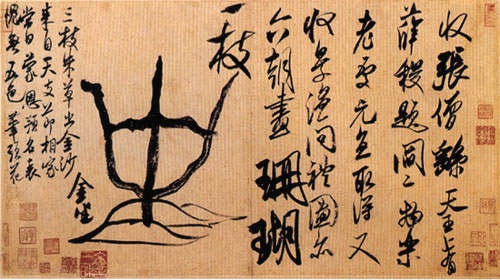
Back to page 2 Chinese Literati Painting -- Page 3 To page 4
The Calligraphic Influence
The "calligraphic" use of the brush became in China a separate art form, and one that exerted great influence on literati painting. Beginning in the period of the Six Dynasties (220-589), mastery of self-expression through well and distinctively written (actually, "brushed") characters was an important part of being a well bred member of the elite. The earliest exemplars of calligraphic mastery were members of the refugee elite families of Southern China, who were apparently influenced by a tradition of inspired "automatic writing" associated with traditions of Daoist religious practice. Foremost among these was Wang Xizhi (303-361), whose calligraphy has remained one exemplar for the art of writing in China ever since, and whose brush style contributed to the common standard "font" for writing Chinese characters throughout the traditional period. (The example below, from his most famous work and bearing the seals of a Qing Dynasty emperor, is likely a copy rather than an original, as is probably true of all existing remnants of his style.)

A number of men became famous for their fine calligraphy, and examples of their styles were preserved through carvings, which traced their brushstrokes in stone. These carved examples were circulated through ink rubbings of the stone that replicated the brushwork in intaglio (blank-and-white reverse), and over time, collections of exemplary styles became the basis for educating the young in calligraphic skill. Here is an example from the Tang era calligrapher Yan Zhengqing (709-85), a man whose "upright" formal style resonated with accounts of his exemplary Confucian conduct during the difficult times of the An Lushan Rebellion.


Over time, men of literary learning tried to master one or more of these classical styles, and bring to them also a unique individuality. Thus the medium of writing -- handwriting, so to speak -- became an important way of expressing one's nature and of reading the character of others. Here are some interesting examples of the art of calligraphy, dating from later eras:
The refined and regular style of Zhao Ji (1082-1135), who ruled as Emperor Huizong of the Northern Song Dynasty (ending his life as a captive of the Jurchen Jin court, which drove the Song court out of northern China in 1127), shows individual creativity within the confines of standard character forms (right).
Personal expressiveness in calligraphy led to wild and eccentric examples of writing. This type of calligraphy, often using dramatic character forms called "grass" script, was sometimes intended more for aesthetic power than legibility. The wild style was pioneered by Zhang Xu (c. 675-759) during the Tang era - a portion of his handscroll inscription of four poems illustrates this style. Beneath it is a scroll by the eccentric Ming literatus Xu Wei (1521-1593) of the Ming [1368-1644], known equally for wild calligraphy and art and for his bizarre personal conduct:


A more restrained style of calligraphy could express a sense of creativity, unconstrained by the "grid" of formal characters, while retaining legibility - a balance of individuality and conformity that suggests the complex components of the literati persona. This type of calligraphy often employs an intermediate style known as "running script." Here are examples by Mi Fu (1051-1107), an unconventional painter and calligrapher of the Northern Song [960-1127] (below, left), and the Qing [1644-1911] calligrapher, Zheng Xie (1693-1765), who developed an aesthetically pleasing, uneven style that continues to be a model for some calligraphers today:

